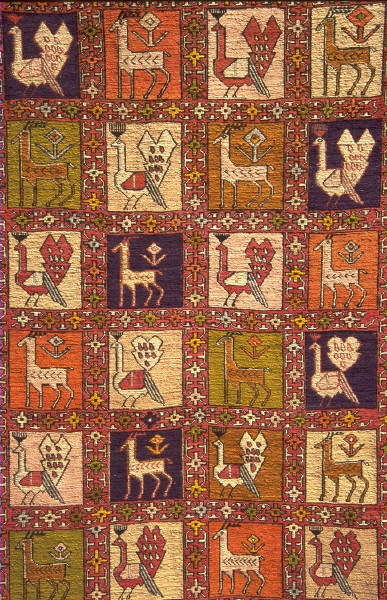THE KEEPING QUILT
By Patricia Polacco
When my Great-Gramma Anna came to America, she wore the same thick overcoat and big boots she had worn for farm work. But her family weren’t dirt farmers anymore. In New York City, her father’s work was hauling things on a wagon, and the rest of the family made artificial flowers all day.
Everyone was in a hurry, and it was so crowded, not like back home Russia. But all the same it was their home, and most of their neighbors were just like them.
When Anna went to school, English sound to her like pebbles dropping into shallow water. Shhhhh . . Shhhhhh . . . Shhhhhh. In six months she was speaking English. Her parents almost never learned, so she spoke English for them, too.
The only things she had left of backhome Russia were her dress and babushka she liked to throw up into the air when she was dancing.
And her dress was getting too small. After her mother had sewn her new one, she took her old dress and babushka. Then from a basket of old clothes she took Uncle Vladimir’s shirt, Aunt Havalah’s nightdress, and an apron of Aunt Natasha’s.
“We will make a quilt to help us always remember home.” Anna’s mother said. “It will be like having the family in backhome Russia dance around us at night.”
And so it was. Anna’s mother invited all the neighborhood ladies. They cut out animals and flowers from the scraps of clothing. Anna kept the needles threaded and handed them to the ladies as they needed them. The border of the quilt was made of Anna’s babushka.
On Friday nights Anna’s mother would say the prayers that started the Sabbath. The family ate challah and chicken soup. The quilt was the tablecloth.
Anna grew up and fell in love with Great-Grandpa Sasha. To show he wanted to be her husband, he gave Anna a gold coin, a dried flower, and a piece of rock salt all tied into a linen handkerchief. The gold was for wealth, the flower for love, and the salt so their lives would have flavor.
She accepted the hankie and they were engaged.
Under the wedding huppa, Anna and Sasha promised each other love and understanding. After the wedding, the men and some men celebrated separately.
When my Grandma Carle was born, Anna wrapped her daughter in the quilt to welcome her warmly into the world. Carle was given a gift of gold, flower, salt, and bread. Gold so she would never know poverty, a flower so she would always know love, salt so her life would always have flavor, and bread so that she would never know hunger.
Carle learned to keep the Sabbath and cook and clean and do washing.
“Married you’ll be someday,” Anna told Carle, and . . . again the quilt became a wedding huppa; this time for Carle’s wedding to Grandpa George. Men and women celebrated together, but they still did not dance together. In Carle’s wedding bouquet were gold coin, and salt.
Carle and George moved to a farm in Michigan and Great-Granma Anna came to live with them. The quilt once again wrapped a new little girl, Mary Ellen.
Mary Ellen called Anna, Lady Gramma. She had grown very old and was sick a lot of the time. The quilt kept her legs warm.
On Anna’s ninety-eight birthday, the cake was a kulich, a rich cake with raisings and candied fruit in it.
When Great-Granma Anna died, prayers were said to lift her soul to heaven. My mother Mary Ellen was now grown up.
When Mary Ellen left home, she took the quilt with her. When she became a bride, the quilt became her huppa. For the first time, friends who were not Jews came to the wedding. My mother wore a suit, but in their bouquet were gold, bread, and salt.
The quilt welcomed me, Patricia, into the world. . . and it was the tablecloth for my first birthday party.
At night, I would trace my fingers around the edges of each animal on the quilt before I went to sleep. I told my mother stories about the animals on the quilt. She told me whose sleeve had made the horse, whose apron had made the chicken, whose babushka went around the edge of the quilt.
The quilt was a pretend cape when I was in the bullring, or sometimes a tent in the steaming Amazon jungle.
At my wedding, men and women danced together. In my bouquet were gold, bread, and salt – and a sprinkle of grape juice, so I would always know laughter.
Many years ago I held Traci Denise in the quilt for the first time.
Three years later my mother held Steven John in the quilt for the first time. We were all so proud of Traci’s new baby brother.
Just like their mother, grandmother, and great-grandmother before them, they, too, used the quilt to celebrate birthdays and make superhero capes.
As the years passed and Traci and Steven were growing up, their grandmother took pleasure at every family gathering to tell the story of the quilt. We all knew whose clothes made each flower and animal. My mother was lucky enough to show the wonder of this quilt to my brother’s grandchildren, her great-grandchildren.
When my mother died, prayers were said to lift her should to heaven. Traci and Steven were now all grown up and getting ready to start their own lives.
And now I wait . . . for the day that I, too, will be a grandmother, and tell the story of the Keeping Quilt to my grandbabies.
